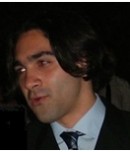

Plenary Lecture
Contribution of Knee Joint Mechanics to the Structure and Properties of Its Underlying Articular Cartilage: The Mechanical Engineering Perspective

Dr. Daniel M. Espino
School of Mechanical Engineering
University of Birmingham
England, UK
E-mail: daniel.m.espino@gmail.com
Abstract: The aim of this session is to discuss how loading conditions that the knee joint is exposed to influence the structure and mechanical properties of the underlying articular cartilage. This is important as cartilage degeneration, as occurs during osteoarthritis, involves changes to structure and properties. Different joints across the body are exposed to different movements and, thus, loading. For example, the loads and stresses experienced by the hip are different to those experienced by the knee during walking or running. Different joints also experience different rates of cartilage degeneration. The ankle, while exposed to higher stress experiences little cartilage degeneration unlike the hip or knee. Variation in structure and mechanical properties occur across different joints, within a joint and within a joint component. The knee is a good example of this.
The medial and lateral components of the knee are exposed to different types of loading. During walking, the lateral knee rotates unlike the more static medial knee. However, most compressive loads pass through the medial knee. Load distribution across the knee is affected by its components (the patella, menisci and ligaments). Variation in the structure and properties of articular cartilage across the knee joint are thus examined based on these differences in the conditions that articular cartilage across the knee is exposed to.
As articular cartilage is a viscoelastic material variation in its viscoelastic properties across the knee are presented. These results include recent research at our laboratory on dynamic mechanical analysis performed on articular cartilage, leading to its frequency dependent viscoelastic characterisation (i.e. storage and loss moduli).
The session includes:
- background to the knee, its anatomy and physiological loading;
- description of the differences in the structure of articular cartilage;
- detail of viscoelastic characterisation of articular cartilage and their variation across the knee;
- discussion of trends between structure and viscoelastic properties of cartilage and their relevance to physiological loading across the knee joint.
Brief Biography of the Speaker: Daniel is currently a Research Fellow at the University of Birmingham, funded by an Intra-European Personal Fellowship. Over the last 10 years he has developed his research experience in Bio-medical Engineering through computational simulation and mechanical testing of biological tissues of the body. Recently, this has included investigating articular cartilage and its involvement in knee joint mechanics. He obtained his PhD in Bio-Engineering at the University of Aberdeen. Following his PhD, he was awarded a Junior Fellowship by the British Heart Foundation which he held at the School of Mechanical Engineering, University of Birmingham. He has since developed his expertise outside the UK, as a Research Fellow at both the School of Engineering, University of Auckland (New Zealand) and the Medical Technology Laboratory, Istituto Ortopedico Rizzoli in Bologna (Italy).
He has been invited to present his research in the Czech Republic, Greece, Switzerland and the UK. He has served on the conference committee for the International Conference of Systems Biology and Bioengineering and the 2nd Workshop on 3D Physiological Human. He has also been invited to the editorial boards for the International Journal of Engineering & Technology, International Journal of Biological Engineering, Open Journal of Orthopedics, and the Journal of Clinical Rehabilitative Tissue Engineering Research.